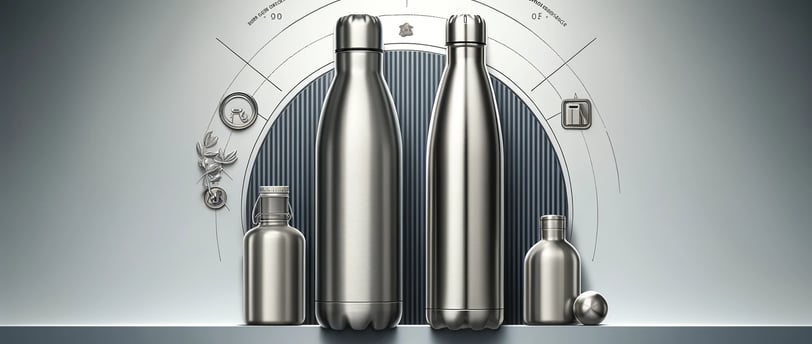Choosing the Best Stainless Steel for Insulated Water Bottles: 304 vs. 316
Imagine a bottle that keeps your drinks at the perfect temperature, whether you're at work or hiking outdoors. Choosing between 304 and 316 stainless steel can be a game-changer in durability and convenience. This guide will walk you through the unique benefits of each type so you can find the perfect bottle to fit your lifestyle needs.
DISCOVER THE SECRETS OF STAINLESS STEEL
Lin Davi
11/2/20242 min read


Choosing the Best Stainless Steel for Insulated Water Bottles: 304 vs. 316
Introduction
The use of stainless steel water bottles is a non-negotiable need for those conscious of health and living sustainably. The debate between 304 and 316 stainless steel is quite befitting and very relevant, especially for those end-consumers who value their money while aiming for quality. Here goes an in-depth analysis between 304 and 316 stainless steel to help you make a proper decision.
Key Differences between 304 and 316 Stainless Steel
Material Composition - Corrosion Resistance
304 Stainless Steel: This is a common, food-grade stainless steel alloy with roughly 18% chromium and about 8-10% nickel. Such a combination ensures good resistance to most corrosive elements for general applications and has proved to be tough enough under standard day-to-day conditions.
316 Stainless Steel: This is considered the high-end grade, as it contains an additional 2% molybdenum, which provides greater resistance in salty water and acidic conditions; thus, this would be ideal for outdoor or high-exposure conditions.
Durability for Long-Term Use
304 Stainless Steel: This is very good for normal day-to-day use. It is resistant to wear and tear, thus making it a very good choice for the majority of the consumers whose needs are also not very extreme.
316 Stainless Steel: It makes this stainless steel more resistant to extreme conditions and long-term exposure to cruel elements; it would do very well for users using their bottles in demanding marine or highly polluted environments.
Health and Safety
304 Stainless Steel: Non-toxic and safe for food, 304 finds broad applications in cookwares and drinking utensils. These have a tendency to leach traces of nickel, especially over time, but generally pose no health risk.
316 Stainless Steel: Even less likely to leach than the former, 316 is preferred for baby bottles and medical equipment. It's ideal for those with nickel allergies or concerning exposure to chemicals at high temperatures.
Comparison of Costs
304 Stainless Steel: This material is the most economical among the three and fairly easy to source; yet, it does not compromise on performance. 304 stainless steel is perfect for those users who are conscious about obtaining durability without any unnecessary add-ons.
316 Stainless Steel: With more components added in its making, this metal is costlier and more resistant to corrosion. It is ideal for very specific applications that need to be durable in respect to safety, but to the casual user, it may be overkill at additional expense.
Which Grade Suits Your Needs?
If you're considering an insulated water bottle for regular day-to-day use, 304 stainless steel is an excellent option that is durable, affordable, and safe. If your bottle is likely to face harsher environments, 316 stainless steel provides greater corrosion resistance.
Why Choose ChengRuo's Stainless Steel Water Bottles?
As one of the leading companies in stainless steel insulated cups production, ChengRuo Co. manufactures every product line using high-grade 304 and 316 Stainless Steels. With the best quality and durability assured, all products highly satisfy customers. It offers customer-tailored designs to suit customer preferences and full support in the manufacturing process of the products. For this reason, ChengRuo is an excellent partner for individual clients and business ones.
Keywords:
304 vs. 316 stainless steel water bottle
Food-grade stainless steel used for water bottles
Resistance to Corrosion in Stainless Steel Drinkware
Best grade of stainless steel in terms of durability
Conclusion
Whether you view insulated bottles as a solution for daily hydration or as something for rougher use, knowledge of what makes 304 different from 316 stainless steel will help in choosing the best option for your lifestyle. Both options are equally safe; however, choosing the right grade will give you maximum value for money in the form of durability and health.
Quality
Professional manufacturer of insulated cups in China.
Innovation
Design
+86 18868467314
Copyright © 2012 - 2024, Chengruo Limited. All rights reserved.
